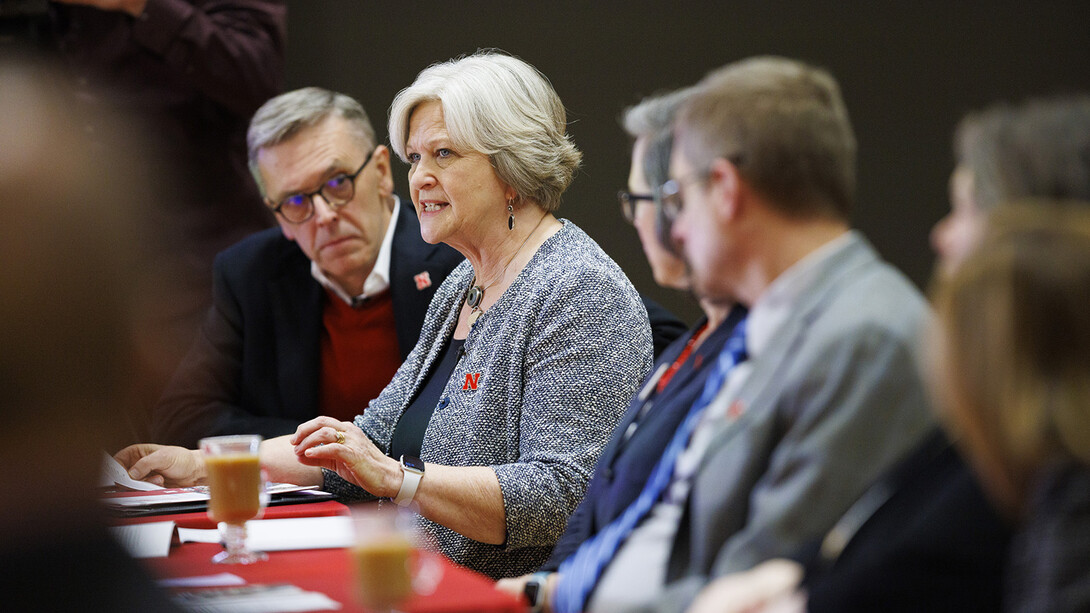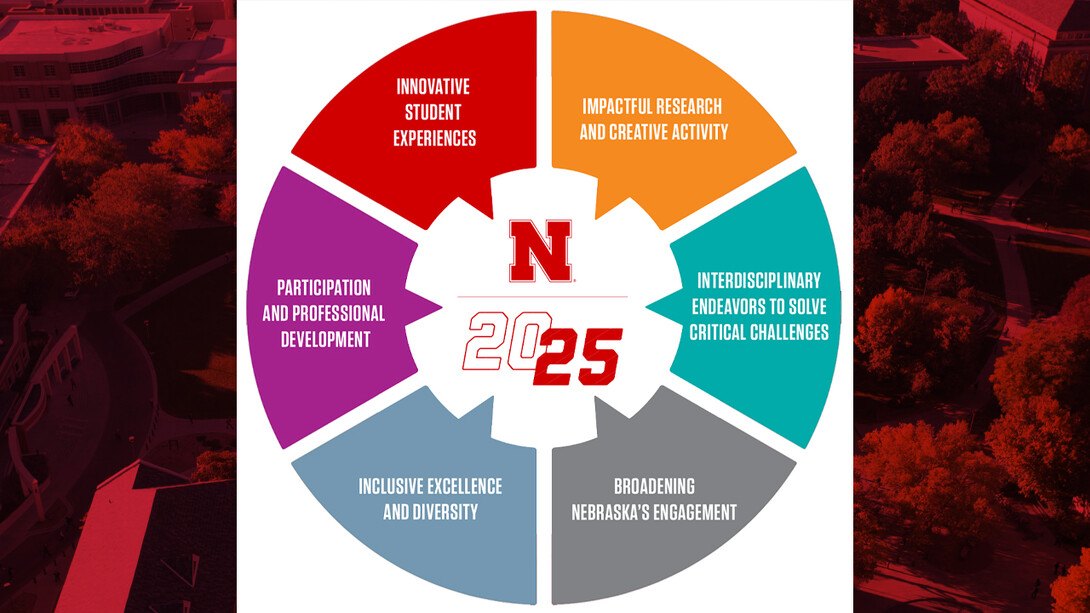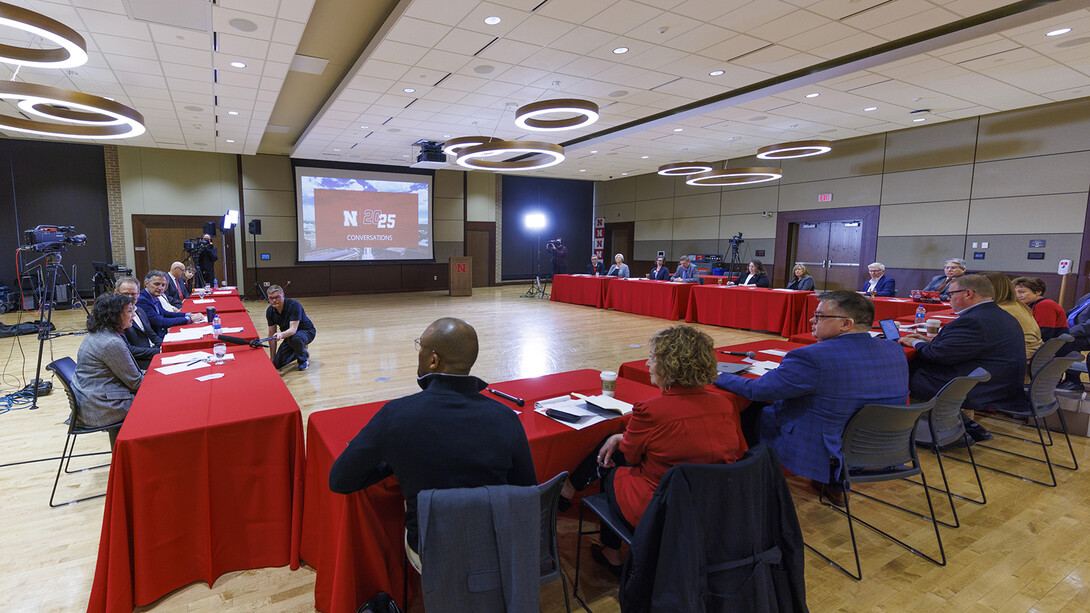
To help Huskers earn greater achievement on campus and prepare for career success, the University of Nebraska–Lincoln is moving forward with its N2025 strategic plan goal to expand experiential learning opportunities available to all students.
As the university enters the third year of the strategic plan, campus leaders recently gathered to discuss progress made toward the document’s six aims and related goals. Videos from the discussions are being released through April 25 with a weekly theme tied to each of the N2025 aims.
The first video, available below and on the N2025 website, is focused on what is colloquially known as “Aim One,” which calls for the university to “innovate student experiences that prepare graduates to be life-long learners and contributors to the workforce in Nebraska and the world.” Additional videos highlighting experiential learning programs related to this aim will be released March 23.
Outlined as a key component of the university’s N2025 strategic plan, experiential learning encompasses any engaged opportunity for a student to learn through hands-on doing and reflection. The goal is directly tied to the university’s desire to improve its four- and six-year graduation rates and reduce the institution’s equity gap.
“This experiential component is a big goal in our N2025 plan,” Chancellor Ronnie Green said. “It is, perhaps, our biggest goal related to bolstering and growing the student experience at Nebraska.”

Per the N2025 plan, the university aims to increase its four-year graduation rate to 55% and the six-year graduation rate to 88%. Other targets include a first- to second-year retention rate of 88%; reducing the equity gap in degree completion by slightly more than 50%, from 14.4% to 7%; growing graduate and undergraduate enrollment by 15%; increasing to 10% the students engaging in study-abroad programs in an academic year; and all graduates having a documented experiential learning portfolio at graduation.
Amy Goodburn, senior associate vice chancellor and dean of undergraduate education, reported that the university is making progress toward the graduation goal — a result buoyed by a 47.3% four-year rate (the best in the university’s history) in 2021. However, the equity gap has moved in the opposite direction, growing from 10.1% in 2013 to 16.8% in 2017.
“The gap has grown by more than 5% in the last five years,” Goodburn said. “Fortunately, we now have data and reports to help departments identify and monitor equity trends in courses and programs.”
Faculty are now using the reports to examine curriculum to better address classroom challenges. And, the university is also part of an Association of Public Land-grant Universities’ initiative focused on both degree completion and closing the equity gap.
Experiential learning opportunities — which are a requirement for graduation starting for all undergraduates with the class that enters in fall 2022 — will also help the university meet these goals.
“Experiential learning is the lever by which we can accomplish (graduation rate and equity gap) goals,” Goodburn said. “It is especially powerful for historically underserved students, leading to higher retention and graduation rates, providing experiences that they might not have access to in their home communities.”
Colleges have already shifted to help the university meet the goal for experiential opportunities. Key programs highlighted in the discussion include:
Launch of the Experience Lab, which offers real-world career opportunities across all disciplines in the College of Journalism and Mass Communications;
Creation of the Husker Venture Fund, which offers funding for student venture capital and startup ideas, in the College of Business;
The College of Arts and Sciences received a $1 million lead gift from an alumnus to create a program that offers access to experiential learning to all students;
All students in the College of Education and Human Sciences already participate in career-building experiences, however they continue to shape programs to meet needs, including offering the Teachers Scholar Academy, which is a learning community for pre-service teachers in the college as well as students in the College of Agricultural Sciences and Natural Resources and College of Fine and Performing Arts;
Every undergraduate in the College of Architecture completes the design 410 Studio, a collaborative studio for fourth-year students that develop real-world projects with Nebraska communities;
Students in the College of Engineering are guaranteed to complete two of three opportunities — a paid internship with a company, undergraduate research experience and a study-abroad program;
Clinics in the College of Law offer its students on-the-ground training that helps them prepare to be civil litigators, prosecutors, immigration attorneys, entrepreneur lawyers, and representatives for children as guardians at litem;
The College of Agricultural Sciences and Natural Resources offers a range of opportunities, from the Engler Entrepreneurship Program to Rural Futures Fellows, a concept that pairs students with communities to complete impactful and localized projects;
Experiential learning is offered across all programs in the College of Fine and Performing Arts, including the recently added Emerging Media Arts program;
In the Graduate College, graduate students work directly with faculty on research and creative activity projects, and they serve as day-to-day supervisors of the university’s UCARE program, which offers hands-on lab experiences to undergraduates; and
The University Libraries continue to expand upon its work to support all colleges with their experiential learning offerings while also giving real-world research opportunities through the Center for Digital Research in the Humanities.

Further efforts are also in progress, both at the institution and individual college level, to close the equity gap — which is the graduation rate of underrepresented minority students compared to the all students.
Through the APLU initiative, the university is working directly with other institutions (including seven Big Ten schools).
“We’re always looking at institutional barriers that are common in our institutions,” Goodburn said. “We want to find ways to dismantle them so that students can be successful.”
The video includes a discussion on challenges the university faces in meeting this goal.
One particular challenge is how to tailor a program to meet the unique needs of individual students. The group pointed to successes in learning communities, Center for Transformative Teaching offerings, co-curricular activities and peer-to-peer mentoring as possible ways to better help individual students advance toward graduation and career success.
“When talking about Aim One and growing our student experience, I think we’re well on our way to achieving the N2025 goals,” Green said.







